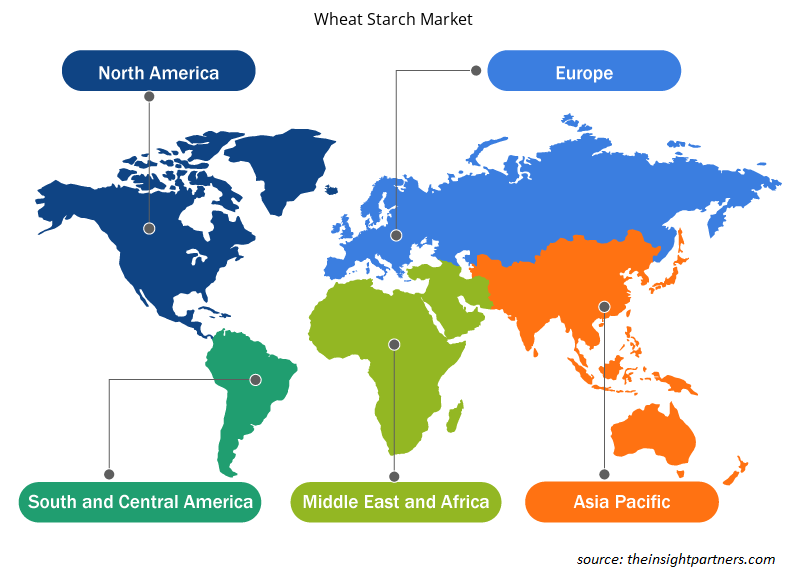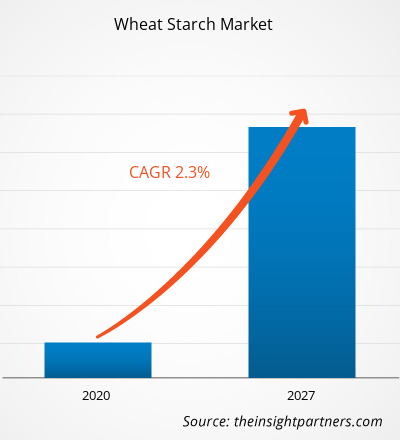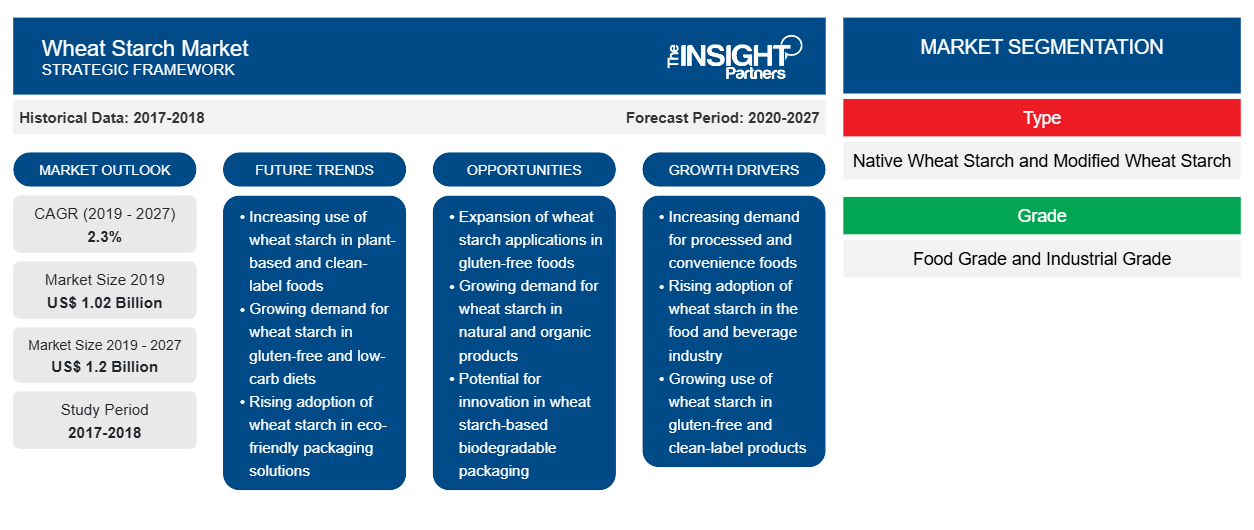밀 전분 시장 규모는 2019년에 10억 1,695만 달러로 평가되었으며, 2027년까지 12억 332만 달러에 도달할 것으로 예상됩니다. 예측 기간 동안 연평균 성장률 2.3%로 성장할 것으로 예상됩니다.
밀 전분은 뛰어난 겔화, 안정화 및 증점 특성을 가지고 있습니다. 식품에 사용될 때 밀 전분은 원하는 질감과 점도를 부여하는 데 도움이 되며, 겔 제형, 결합 및 수분 유지를 가능하게 합니다. 주로 식품 산업에서 증점제로 사용됩니다. 밀 전분은 퇴화 및 젤라틴화를 통해 식품을 증점합니다. 열은 전분이 물을 흡수하고 부풀어 오르면서 투명도와 점도를 증가시킵니다. 그러나 최대 점도 수준에 도달하면 분자가 떨어져 점도가 감소합니다. 또한 제품이 다시 식기 시작하면 점도가 증가하여 용액이 흐려져 겔이 형성됩니다. 이것이 식품 및 음료 제조업체가 식품에 밀 전분을 사용하는 것을 선호하는 이유 중 하나입니다. 요즘에는 베이킹에도 열 전분의 사용이 증가하고 있습니다. 변형된 밀 전분은 특정 식품에서 뛰어난 유화 특성을 부여합니다. 또한 터키식 디라이트와 같은 제과류에도 적용됩니다. 또한 맥주의 거품 유지력을 개선하는 데 효과적입니다. 소시지와 미트롤을 만드는 데에도 사용됩니다. 밀 전분은 파스타의 주요 성분이며 무게의 약 70%를 차지합니다. 다른 전분 유형에 비해 밀 전분은 케이크의 부피와 부드러움을 증가시키고 도넛의 지방 흡수에도 도움이 됩니다. 밀 전분은 포도당 시럽, 말토덱스트린, 덱스트로스와 같은 감미료에 일반적으로 사용됩니다. 소스와 푸딩의 안정제로 사용됩니다.
아시아 태평양 지역은 예측 기간 동안 글로벌 밀 전분 시장 에서 상당한 점유율을 차지할 것으로 예상됩니다 . 여러 국내 및 국제 기업이 이 지역에서 강력한 입지를 확보하고 있습니다. APAC 국가의 중산층 인구 증가와 도시화 증가는 주요 밀 전분 시장 참여자에게 여러 기회를 제공합니다. 원자재(밀)의 쉬운 가용성은 APAC 시장 성장을 뒷받침하는 데 중요한 역할을 합니다. 중국은 2019년 아시아 태평양 밀 전분 시장을 지배했으며 예측 기간 동안 시장을 선도할 것으로 예상됩니다. 중국의 지배력은 주로 혁신적인 밀 전분 제품 개발에 대한 기업의 지출 증가와 해당 국가에 확립된 식품 및 음료 부문의 존재에 기인합니다.
COVID-19 발병은 2019년 12월 우한(중국)에서 처음 보고되었으며, 그 이후로 전 세계적으로 빠른 속도로 확산되었습니다. 2020년 12월 현재 미국, 인도, 브라질, 러시아, 프랑스, 영국, 터키, 이탈리아, 스페인, 독일, 아르헨티나, 콜롬비아, 멕시코가 이 팬데믹으로 가장 큰 피해를 입은 국가에 속합니다. WHO에 따르면 12월 현재 전 세계적으로 COVID-19 확진 사례가 약 80,773,033건, 사망자가 1,783,619건입니다. COVID-19는 봉쇄, 여행 금지, 사업 중단으로 인해 다양한 국가의 경제와 산업에 영향을 미쳤습니다. 식음료는 공급망 중단, 기술 이벤트 취소, 사무실 폐쇄와 같은 심각한 혼란을 겪고 있는 세계의 주요 산업 중 하나입니다. 중국은 글로벌 제조 허브이자 다양한 산업의 가장 큰 원자재 공급업체입니다. 중국의 다양한 공장과 공장의 봉쇄는 글로벌 공급망에 영향을 미치고 제조, 납품 일정 및 자재 판매에 부정적인 영향을 미치고 있습니다. 다양한 회사들이 이미 제품 배송 지연 가능성과 향후 제품 판매 침체를 발표했습니다. 이에 더해 유럽, 아시아, 북미 국가들이 부과한 글로벌 여행 금지령이 사업 협력 및 파트너십 기회에 영향을 미치고 있습니다.
귀하의 요구 사항에 맞게 이 보고서를 사용자 정의하세요
이 보고서의 일부 또는 국가 수준 분석, Excel 데이터 팩을 포함하여 모든 보고서에 대한 사용자 정의를 무료로 받을 수 있으며 신생 기업 및 대학을 위한 훌륭한 혜택과 할인 혜택을 이용할 수 있습니다.
-
이 보고서의 주요 시장 동향을 알아보세요.이 무료 샘플에는 시장 동향부터 추정 및 예측까지 다양한 데이터 분석이 포함됩니다.
시장 통찰력
제약 제형에서 밀 전분의 잠재적 응용 분야가 시장 성장을 촉진합니다.
전 세계의 연구원과 약사들은 이 전분의 향상된 기능과 적용성을 활용하기 위해 제약 제형에서 변형 전분의 잠재력을 발견하기 위해 노력하고 있습니다. 연구는 제약 부형제의 기본 요구 사항과 화학적, 생명공학적, 물리적 방법과 같은 전분 변형 방법에 초점을 맞추고 있습니다. 밀, 옥수수, 쌀 등에서 추출한 전분은 무색, 무취이며 알코올과 물에 녹지 않습니다. 제약 생산에서 전분은 다재다능하고 저렴한 중요한 부형제 역할을 합니다. 토종 밀 전분은 고체 투여 형태의 결합제 및 붕해제로 잘 탐구되고 있습니다. 전분은 질감, 안정성 및 점도와 같은 물리화학적 특성을 향상시켜 제약 응용 분야에서 우수한 흐름성과 압축성을 갖도록 변형되고 있습니다. 따라서 변형 전분은 현재 제약 산업에서 직접 압축 가능한 부형제로 선호되고 있으며, 이는 밀 전분 시장 성장을 촉진하고 있습니다.
유형 통찰력
유형에 따라 밀 전분 시장은 토종 밀 전분과 개질 밀 전분으로 세분화됩니다. 2019년에는 토종 밀 전분 세그먼트가 시장을 지배했습니다. 밀 전분의 물리적 추출은 글루텐과 다른 단백질을 분리합니다. 토종 밀 전분은 또한 밀에서 파생된 식품에 사용되는 식물성 성분입니다. 그것은 중성 냄새와 맛을 가진 흰색에서 흰색에 가까운 분말입니다. 그것은 4kcal/g의 에너지 값을 가지고 있습니다. 즉, 다른 모든 탄수화물과 유사합니다. 토종 밀 전분은 증점제, 안정화제, 흐림 및 유약제로 사용됩니다. 게다가 그것은 또한 결합 및 수분 유지에 사용될 수 있습니다. 그것은 설탕 과자, 제빵 제품, 간식, 유제품(예: 치즈), 알코올 음료, 소스 및 수프, 파스타, 인스턴트 식사, 육류 및 해산물(예: 스리미)에 사용됩니다.
학년 통찰력
등급에 따라 밀 전분 시장은 식품 등급과 산업 등급으로 구분됩니다. 2019년에는 식품 등급 세그먼트가 시장을 지배했습니다. 밀 전분은 일반적으로 식품 및 음료 부문에서 건강 보충제로 사용되며 지방 대체제로도 사용할 수 있습니다. 젤라틴화 및 역행 과정을 통해 식품의 증점제 역할을 합니다. 식품 등급 밀 전분은 푸딩, 수프, 소스 및 파이 속과 같은 제품을 두껍게 하거나 강화하는 데 사용됩니다. 질감, 점도, 겔 형성, 접착력, 결합 및 수분 유지에 도움이 됩니다. 이 전분은 또한 고품질 레스토랑, 호텔 및 가정용 조리 응용 분야에서 필수적인 재료입니다.
최종 사용 산업 통찰력
최종 사용 산업을 기준으로 밀 전분 시장은 식품 및 음료, 화장품 및 기타로 세분화됩니다. 2019년에는 식품 및 음료 부문이 시장을 지배했습니다. 식품 산업에서 밀 전분은 증점제로 사용됩니다. 또한 반죽의 탄력성을 방지하는 능력으로 식품 및 음료 부문에서 증점제, 식품 첨가물 및 활성 성분으로 가장 널리 사용됩니다. 또한 식품 결합 과정에 도움이 되며 글루텐이 없고 칼로리가 낮은 식품을 준비하는 데에도 사용됩니다. 많은 식품 응용 분야에서 유화제, 안정제, 지방 대체제 및 흐림 또는 유약제로도 일반적으로 사용됩니다. 또한 만두 포장지에 반투명한 일관성을 부여하는 데 도움이 되므로 중국 만두 포장지의 반죽 레시피에도 사용됩니다. 소비자 사이에서 글루텐이 없는 음식을 소비하는 추세는 식품 및 음료 산업에서 밀 전분 사용을 계속 선호할 것입니다.
글로벌 밀 전분 시장의 주요 기업으로는 Cargill Incorporated, RoquetteFreres, Manildra Group, MGP Ingredients, The Archer-Daniels-Midland Company, Agrana Group, Tereos SA, Crespel and Deiters, New Zealand Starch Company, SacchettoS.pA 등이 있습니다. 이 회사들은 신제품 개발과 합병 및 인수 전략을 실행하여 고객 기반을 확대하고 전 세계적으로 상당한 시장 점유율을 확보하고 있으며, 이를 통해 전 세계적으로 브랜드 이름을 유지할 수 있습니다.
밀 전분 시장 지역 통찰력
Insight Partners의 분석가들은 예측 기간 동안 밀 전분 시장에 영향을 미치는 지역적 추세와 요인을 철저히 설명했습니다. 이 섹션에서는 북미, 유럽, 아시아 태평양, 중동 및 아프리카, 남미 및 중미의 밀 전분 시장 세그먼트와 지리에 대해서도 설명합니다.

- 밀 전분 시장에 대한 지역별 특정 데이터를 얻으세요
밀 전분 시장 보고서 범위
| 보고서 속성 | 세부 |
|---|---|
| 2019년 시장 규모 | 10억 2천만 달러 |
| 2027년까지 시장 규모 | 12억 달러 |
| 글로벌 CAGR (2019-2027) | 2.3% |
| 역사적 데이터 | 2017-2018 |
| 예측 기간 | 2020-2027 |
| 다루는 세그먼트 |
유형별로
|
| 포함된 지역 및 국가 |
북아메리카
|
| 시장 선도 기업 및 주요 회사 프로필 |
|
밀 전분 시장 플레이어 밀도: 비즈니스 역학에 미치는 영향 이해
밀 전분 시장 시장은 소비자 선호도의 변화, 기술 발전, 제품의 이점에 대한 인식 증가와 같은 요인으로 인해 최종 사용자 수요가 증가함에 따라 빠르게 성장하고 있습니다. 수요가 증가함에 따라 기업은 제품을 확장하고, 소비자의 요구를 충족하기 위해 혁신하고, 새로운 트렌드를 활용하여 시장 성장을 더욱 촉진하고 있습니다.
시장 참여자 밀도는 특정 시장이나 산업 내에서 운영되는 회사나 기업의 분포를 말합니다. 주어진 시장 공간에 얼마나 많은 경쟁자(시장 참여자)가 존재하는지 그 규모나 전체 시장 가치에 비해 나타냅니다.
밀 전분 시장에서 운영되는 주요 회사는 다음과 같습니다.
- 카길 주식회사
- 로케트 프레르
- 마닐라드라 그룹
- MGP 성분
- 아처-대니얼스-미들랜드 회사
면책 조항 : 위에 나열된 회사는 어떤 특별한 순서에 따라 순위가 매겨지지 않았습니다.

- 밀 전분 시장 주요 주요 업체 개요를 알아보세요
스포트라이트 보고서
- 플레이어가 효과적인 장기 전략을 개발하는 데 도움이 되는 글로벌 밀 전분 시장의 진보적인 산업 동향
- 선진국과 개발도상국 시장에서 기업이 채택한 사업 성장 전략
- 2017년부터 2027년까지 밀전분 시장 정량분석
- 다양한 산업에 걸친 밀 전분 수요 추산
- 산업에서 운영되는 구매자와 공급자의 효율성을 보여주기 위한 PEST 분석
- 경쟁 시장 상황과 밀 전분 수요를 이해하기 위한 최근 동향
- 시장 동향 및 전망, 시장 성장을 주도하고 제한하는 요인
- 시장 성장과 관련하여 상업적 관심을 뒷받침하는 전략에 대한 이해
- 시장의 다양한 노드에서의 밀 전분 시장 규모
- 시장의 세부적인 개요 및 세분화, 그리고 산업 역학
- 각 지역의 유망한 성장 기회가 있는 다양한 지역의 글로벌 밀 전분 시장 규모
밀 전분 시장, 유형별
- 토종 밀 전분
- 변형 밀 전분
등급별 밀 전분 시장
- 식품 등급
- 산업 등급
최종 사용 산업별 밀 전분 시장
- 음식과 음료
- 화장품
- 기타
회사 프로필
- 카길 주식회사
- 로케트프레르
- 마닐라드라 그룹
- MGP 성분
- 아처-대니얼스-미들랜드 회사
- 아그라나 그룹
- 테레오스 SA
- 크레스펠과 다이터스
- 뉴질랜드 전분 회사
- 사케토 SpA
- 과거 분석(2년), 기준 연도, CAGR을 포함한 예측(7년)
- PEST 및 SWOT 분석
- 시장 규모 가치/거래량 - 글로벌, 지역, 국가
- 산업 및 경쟁 환경
- Excel 데이터세트
최근 보고서
사용 후기
구매 이유
- 정보에 기반한 의사 결정
- 시장 역학 이해
- 경쟁 분석
- 고객 인사이트
- 시장 예측
- 위험 완화
- 전략 기획
- 투자 타당성 분석
- 신흥 시장 파악
- 마케팅 전략 강화
- 운영 효율성 향상
- 규제 동향에 발맞춰 대응























 무료 샘플 받기 - 밀 전분 시장
무료 샘플 받기 - 밀 전분 시장